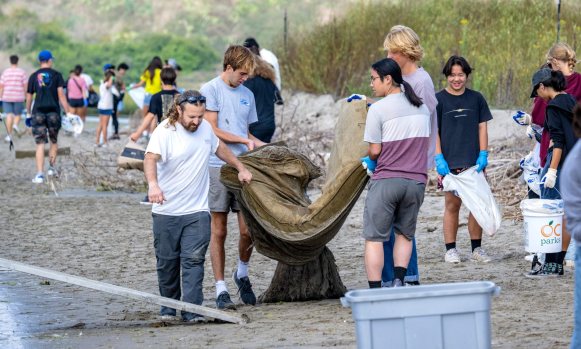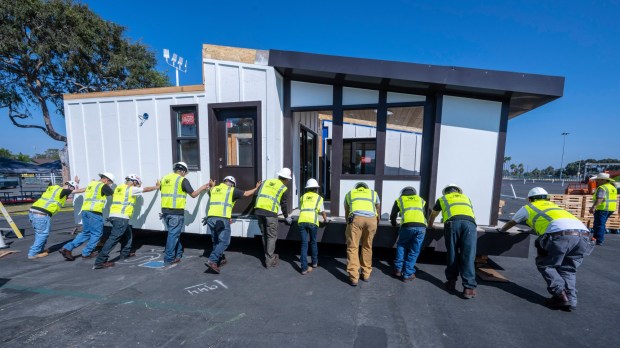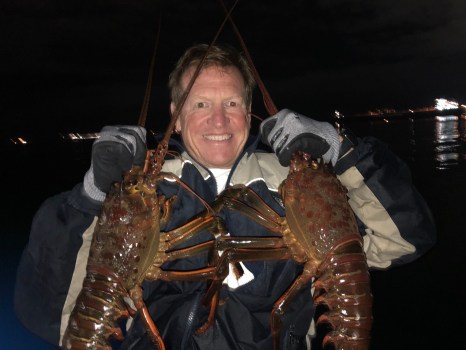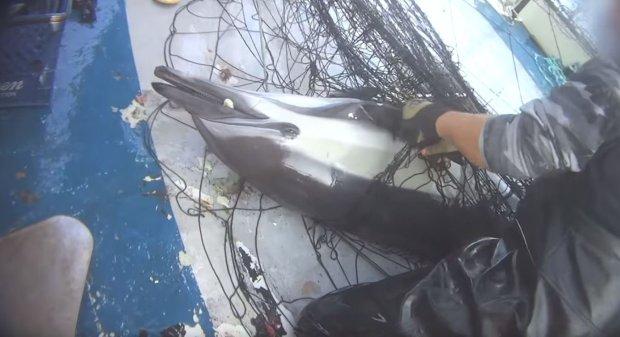
Imagine a future where swordfish can be caught sustainably, without harming marine mammals like whales and dolphins. Thanks to the National Marine Fisheries Service, that future is becoming a reality. The service has recently issued permits for commercial swordfish fishermen to use new deep-set buoy gear. This innovative gear is specifically designed to target swordfish while avoiding accidental capture of marine mammals. It is a major step forward in ensuring both the sustainability of swordfish fishing and the protection of our precious marine ecosystem. As fishermen pave the way with these new permits, a new fishery is set to develop, with 25 new permits being issued each year until 2027. It’s a momentous occasion for the fishing industry and a promising stride towards a more harmonious coexistence between humans and marine life.

This image is property of www.ocregister.com.
Permit Issuance by National Marine Fisheries Service
Background
The National Marine Fisheries Service (NMFS) has recently announced the issuance of the first permits for commercial swordfish fishermen to utilize new deep-set buoy gear. This move comes as part of a comprehensive initiative to promote sustainable fishing practices and protect marine mammals. The permits are aimed at drift net fishermen who have agreed to pioneer the use of the new gear, as well as those who have opted for buyouts to permanently abandon the use of traditional mesh nets.
Purpose
The issuance of these permits serves several important purposes. Firstly, it seeks to introduce and promote the adoption of new deep-set buoy gear within the commercial swordfish fishing industry. This gear is specifically designed to target swordfish while minimizing the capture of non-target species such as whales and dolphins. Secondly, the permitting process allows for the development of a new fishery that prioritizes sustainability and conservation efforts.
Process
The process for obtaining a permit from the NMFS involves a thorough evaluation of the applicant’s qualifications and adherence to the designated criteria for approval. This includes a careful review of the applicant’s fishing practices, history, and their commitment to transitioning to the new gear. The NMFS aims to ensure that permit recipients are genuinely dedicated to sustainable fishing practices and actively contribute to the success of the new gear implementation.
Criteria for Approval
To be approved for a permit, applicants must demonstrate a willingness to transition from using drift nets to utilizing the new deep-set buoy gear. They must also showcase a track record of responsible fishing practices, compliance with existing regulations, and a commitment to conservation efforts. The NMFS evaluates the overall impact of each applicant on marine ecosystems, taking into consideration their potential to minimize bycatch, while maximizing the sustainable harvest of swordfish.
New Deep-Set Buoy Gear: Targeting Swordfish
Introduction
The new deep-set buoy gear represents a significant advancement in swordfish fishing techniques. It has been specifically designed to target swordfish while reducing the unintentional capture of non-target species such as marine mammals. By utilizing this innovative gear, fishermen can precisely focus on swordfish without adversely affecting the ecological balance of the marine ecosystem.
Features
The deep-set buoy gear comprises a combination of buoys, weighted lines, and hooks that are carefully deployed at specific depths to attract and catch swordfish. This gear is characterized by its ability to minimize bycatch and prevent the entanglement of marine mammals. It also incorporates technology to increase the efficiency of swordfish capture and reduce potential harm to the fish.
Benefits
The adoption of the new deep-set buoy gear offers numerous benefits for both fishermen and the marine environment. Firstly, it allows fishermen to target swordfish more effectively, resulting in increased catch rates and profitability. Moreover, by significantly reducing bycatch, the gear helps protect non-target species, such as whales and dolphins, from unnecessary harm. This contributes to the overall conservation efforts aimed at maintaining a sustainable balance in the ocean ecosystem.

This image is property of www.ocregister.com.
Permit Recipients: Drift Net Fishermen
Selection Criteria
Drift net fishermen who are chosen as permit recipients play a vital role in pioneering the implementation of the new gear. The selection process takes into consideration their experience as drift net fishermen, their willingness to transition to the new gear, and their commitment to sustainable fishing practices. Those chosen must demonstrate a clear understanding of the ecological impacts caused by drift nets and show genuine dedication to minimizing these impacts.
Role in Pioneer Gear Implementation
Permit recipients from the drift net fishing community serve as pioneers in the implementation of the new gear. Their firsthand experience and ability to adapt to the alternative techniques and technologies are indispensable in ensuring a successful transition. Their input, feedback, and cooperation contribute significantly to refining the gear and optimizing its effectiveness. These fishermen serve as ambassadors for sustainable fishing practices, leading the way for others to follow.
Permit Recipients: Fishermen Taking Buyouts
Reasons for Buyouts
Some commercial fishermen have chosen to accept buyouts offered by the NMFS as an incentive to transition away from using drift nets. The reasons behind their decision to accept these buyouts vary. The fishermen may have recognized the detrimental environmental impacts of drift nets and wish to support more sustainable fishing practices. Alternatively, they may look to diversify their fishing operations or explore new opportunities within the fishing industry.
Role in Transition to New Gear
Fishermen who have accepted buyouts play a crucial role in facilitating the transition to the use of new deep-set buoy gear. By voluntarily relinquishing their engagement in drift net fishing, they contribute to the reduction of harmful fishing practices. Furthermore, they serve as advocates and ambassadors for sustainable fishing, sharing their experiences and endorsing the efficacy of the new gear to encourage others within the industry to follow suit.

This image is property of www.ocregister.com.
Development of New Fishery
Long-term Plan
The development of a new fishery using the deep-set buoy gear is a long-term plan that aims to ensure the sustainability of swordfish fishing practices. The NMFS envisions a gradual transition, with 25 new permits being issued each year until 2027. This gradual increase in permits allows for a controlled growth of the new fishery, ensuring that it remains economically viable while mitigating potential adverse impacts on the swordfish population and other marine species.
Permit Allocation Scheme
The allocation of permits for the new deep-set buoy gear fishery follows a careful evaluation by the NMFS. The allocation considers various factors such as individuals’ past involvement in drift net fishing, their commitment to sustainable practices, and their ability to adapt to the new gear. A fair and equitable distribution of permits ensures that experienced and dedicated fishermen have the opportunity to participate in the new fishery, promoting both sustainability and economic viability.
Timeline
The timeline for the development of the new fishery is set to be implemented over several years. Each year, 25 new permits will be allocated, gradually phasing out traditional drift net fishing. This allows for a smooth and manageable transition for both fishermen and relevant stakeholders. The extended timeline ensures that the necessary infrastructure, training, and support systems are in place to facilitate the successful adoption of the new gear.
Importance of New Gear for Sustainability
Reduction of Bycatch
One of the key benefits of the new deep-set buoy gear is its ability to significantly reduce bycatch. Unlike traditional drift nets, which unintentionally capture non-target species, this gear is designed to specifically target swordfish. By minimizing incidental bycatch, the deep-set buoy gear plays a critical role in protecting and preserving the delicate ecological balance of the ocean, ensuring the long-term sustainability of not just swordfish, but the entire marine ecosystem.
Advances in Targeted Fishing
The adoption of the new gear marks a significant advancement in targeted fishing practices. The precise positioning of the buoys, weighted lines, and hooks enables fishermen to exclusively target swordfish, minimizing the catch of unwanted species. This targeted approach promotes sustainable fishing by reducing waste, optimizing resource utilization, and safeguarding the genetic diversity and population size of swordfish.
Environmental Impact
The deep-set buoy gear represents a major stride towards minimizing the environmental impact of commercial swordfish fishing. By mitigating the entanglement of marine mammals and reducing the accidental capture of non-target species, the gear helps preserve the overall health and biodiversity of marine ecosystems. This shift towards sustainable fishing practices contributes to the broader global efforts to combat the decline of marine species and protect vulnerable habitats.

This image is property of www.ocregister.com.
Protecting Marine Mammals
Threats to Whales and Dolphins
Whales and dolphins face numerous threats in their marine habitats, ranging from entanglement in fishing gear to habitat degradation and pollution. Traditional drift net fishing poses a significant risk to these marine mammals, as they can easily become entangled and suffocate in the mesh. The deployment of new deep-set buoy gear represents a tangible solution to mitigate this threat and protect the well-being of these majestic creatures.
Mitigation Measures
The adoption of the new gear incorporates various mitigation measures aimed at safeguarding marine mammals. The design and deployment of the deep-set buoy gear help prevent accidental entanglements, reducing the risk to whales and dolphins. In addition, the NMFS actively collaborates with fishermen, researchers, and conservation organizations to further refine the gear and implement innovative strategies to minimize the impact on marine mammals.
Expected Results
The implementation of the new deep-set buoy gear is expected to yield significantly positive results in terms of marine mammal protection. By targeting swordfish more precisely and minimizing bycatch, the gear reduces the chances of harming whales and dolphins. This commitment to safeguarding marine mammals aligns with international conservation goals and contributes to the long-term sustainability and health of the ocean ecosystem.
Research and Monitoring
Research Initiatives
To ensure the ongoing effectiveness and improvement of the new deep-set buoy gear, extensive research initiatives are being undertaken. These initiatives focus on understanding the gear’s ecological impact, assessing its fishing efficiency, and exploring potential advancements in its design. Collaborative studies conducted by scientists, fishery experts, and fishermen provide valuable insights into the functioning of the gear and guide future enhancements.
Monitoring Protocols
A robust system of monitoring protocols has been established to evaluate the performance of the new gear and its impact on target and non-target species. By collecting data on catch rates, bycatch reduction, and overall fishing efficiency, the monitoring protocols ensure effective feedback for continuous improvement and evidence-based decision-making. Regular monitoring allows for the identification of any potential issues or concerns, enabling prompt mitigation measures to be implemented.
Data Analysis
Data analysis plays a crucial role in the continuous evaluation of the new gear’s impact on both target and non-target species. Through comprehensive analysis, scientists and fishery experts can assess the efficiency of the gear in reducing bycatch and its contribution to the sustainability of swordfish harvesting. This data-driven approach enables informed decision-making and the development of adaptive strategies, ensuring the ongoing success of the new fishery.

This image is property of www.ocregister.com.
Challenges and Potential Solutions
Regulatory Compliance
One of the key challenges associated with the transition to the new deep-set buoy gear is ensuring regulatory compliance among fishermen. The NMFS aims to address this challenge through comprehensive education and training programs. By promoting awareness of the importance of sustainable fishing practices and providing guidance on adhering to regulations, potential compliance issues can be mitigated effectively.
Industry Transition
The transition from traditional drift net fishing to the new gear represents a significant change for the commercial fishing industry. To facilitate a smooth transition, the NMFS is actively engaged in providing support, guidance, and training to fishermen. By fostering an environment that encourages collaboration and knowledge sharing, the NMFS ensures that fishermen are equipped with the necessary skills and resources to successfully adapt to the new gear and sustainably harvest swordfish.
Economic Viability
The economic viability of the new deep-set buoy gear fishery is a crucial consideration. The NMFS acknowledges that fishermen need to maintain sustainable livelihoods while adopting the new gear. To address this concern, the NMFS is actively exploring opportunities to provide financial support, grants, and access to alternative markets to offset any potential economic challenges that fishermen may face during the transition period. By supporting economic viability, the NMFS aims to ensure the continued success of the fishery.
Collaboration and Stakeholder Engagement
Partnerships
The successful implementation of the new deep-set buoy gear fishery relies heavily on strong partnerships and collaboration among various stakeholders. The NMFS actively engages with fishermen, conservation organizations, scientists, researchers, and other government agencies to share knowledge, exchange ideas, and formulate effective strategies. By fostering these partnerships, the NMFS creates a supportive network that enhances the implementation, monitoring, and ongoing success of the new fishery.
Public Input
The NMFS recognizes the importance of public input in shaping the future of sustainable fishing practices. To ensure transparency and inclusivity, the NMFS actively seeks input and feedback from the public throughout the permitting process and the development of the new fishery. Public input helps identify concerns, address potential issues, and refine management strategies, ultimately leading to a more comprehensive and effective approach to sustainable swordfish fishing.
Addressing Concerns
Addressing the concerns of various stakeholders is vital for the successful implementation of the new gear and the new fishery. The NMFS actively listens to and addresses concerns raised by fishermen, environmental groups, and concerned citizens. By developing clear channels of communication and providing opportunities for dialogue, the NMFS can work collaboratively with stakeholders to find solutions that balance conservation efforts with the needs and interests of all involved parties.
In conclusion, the issuance of permits for the use of new deep-set buoy gear in commercial swordfish fishing marks a significant step forward in promoting sustainability and protecting marine mammals. The development of a new fishery using this innovative gear, with an emphasis on reducing bycatch and advancing targeted fishing practices, ensures the preservation of swordfish populations and the overall health of marine ecosystems. Through collaboration, research, and ongoing monitoring, the National Marine Fisheries Service and its partners are dedicated to overcoming challenges and providing the necessary support to fishermen, thus ensuring the long-term success of this sustainable fishing initiative.
